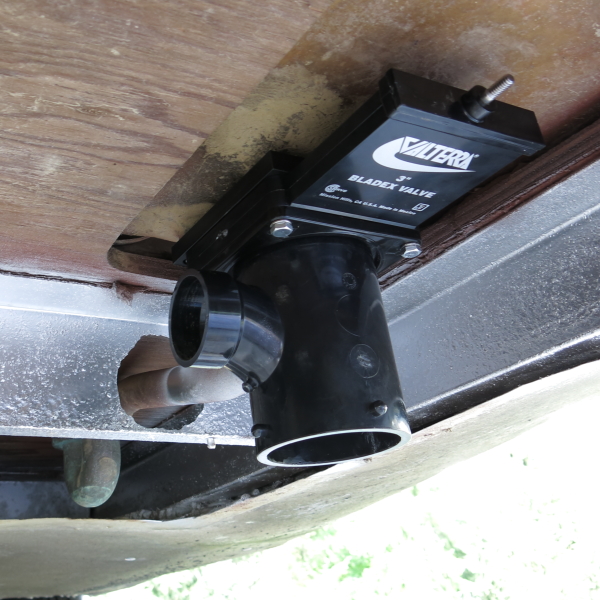My wife and I had a family goal to try to use the trailer for the first time by Labor Day.
We bought the trailer in mid-April but it took a long time to get everything on the punch list checked off. Looking back, it was a pretty extensive list - a baker's dozen, and this is just the major things.
1. Polish the outside skin
2. Replace the axle, inspect frame, and reattach belly pan
3. Install a new LPG hot water heater
4. Install a 30 Amp shore power connection
5. Replace the hot and cold water lines with PEX
6. Install a new fresh water pump with strainer.
7. Replace both sink faucets, repair bath shower and sink sprayer, confirm toilet is operational
8. Repair the LPG lines, install new regulator
9. Confirm the refrigerator works, repair if necessary (or possible)
10. Come up with a solution to connect a sewer hose to the old style Thetford dump valve.
11. Install a converter to charge the 12V system while on shore power
12. Install a city water connection
13. Build and install a new screen for the front window
By the first of September all of the items had been checked off. Someday I may do a total gut-job and replace the floor, rewire everything, etc. but for right now the rig is completely roadworthy with most of the comforts of home.
So it was time to go somewhere - but where?
I've gone camping plenty of times with my son in the Boy Scouts but I've never gone camping with my family in a non-scout related genre. It turns out there are quite a few Airstream-only campgrounds scattered across the US and the closest one was in New Jersey, not too far from the beaches near Avalon and Cape May. We hadn't made it to the beach this year so this was the perfect destination... at least my wife and I thought so, the kids weren't completely sold on the idea.
Fortunately, they haven't reached the age of majority so they don't get to vote. We packed up two-nights worth of "stuff" and hit the road.
My tow vehicle is a 2012 Tacoma 4x4 with the tow package. It will easily tow the 3,000 lbs Safari but I need to be careful not to over load the truck and eat into the payload rating too. The trailer is light enough that I don't need a weight distributing hitch. I did install an anti-sway bar, just to be on the safe side.
Cecil is all hooked up and ready to hit the road.
The speed limit on the Commodore Barry Bridge is just my style... turtle speed.
The Jersey Shore Airstream Haven is located about 15 minutes from the beach, or the "shore" as they say in these parts. It's a nice campground with 98 wooded sites, a clean pool, nice pavilion and other utilities. Of the 98 sites, all but 7 have full timers occupying them. So there are 7 sites available for visitors, plus the rally field for overflow.
The people are very friendly and we felt right at home.
There are about a dozen Airstreams in storage in the campground. It reminded me of an elephant graveyard as many of them were, shall we say, in varying degrees of disrepair.
I was pleasantly surprised to find that our 1961 Safari was one of the nicest looking vintage campers in the campground. There were a couple of almost-new looking RVs too but most Airstreams on site looked well-lived in.
We set up our site with the camper on one side and my son's tent on the other. Our awning spanned the difference and made a cozy spot to sit and enjoy the breeze. Based on the grins, this wasn't going to be too bad.
I haven't been to "the shore" in 25 years. We tend to frequent the beaches further South. We went into Avalon, just a 15 minutes drive, for dinner and to see the sights. One of the things I'm not keen on about New Jersey beaches is you often have to pay for a "beach badge" to access the water. However, after 5:00 no badge is required so we got to enjoy the ocean for a little while, free of charge.
My daughters enjoyed reenacting the bow scene from "The Titanic" using the life guard's skiff as a prop.
Avalon is a nice little town and is lit up with Christmas lights in the evening. My son is smiling widely - that's because this is before the family trounced him in putt-putt golf.
The best part of waking up in a campsite is to make coffee the old fashioned way, in a percolating pot.
On day two we went to Cape May - a beautiful little touristy town on the Southern-tip of New Jersey. From there you need to cross the Delaware river to go further South. Among the sites we visited was a winery and then a micro-brewery where my wife and I enjoyed several samples of interesting brews and my kids enjoyed root beer and ginger ale made on site.
After our second night, all that was left to do was to pack up. But first, I had to make a run to Kohler's Bakery in Avalon for some sticky buns and creme-filled donuts. That was okay though, as it gave me time to fill up the truck with gas.
Coming back on Sunday on Labor Day weekend meant we enjoyed very little traffic on the way home. My wife's photo of Cecil through her windshield looks almost like a watercolor. It was a beautiful day for a leisurely drive back home.
Our first trip in the camper was a complete success. All systems worked, we had no major issues or goof ups and best of all, I think the kids even enjoyed themselves a little.
We'll definitely be doing this again.

















































